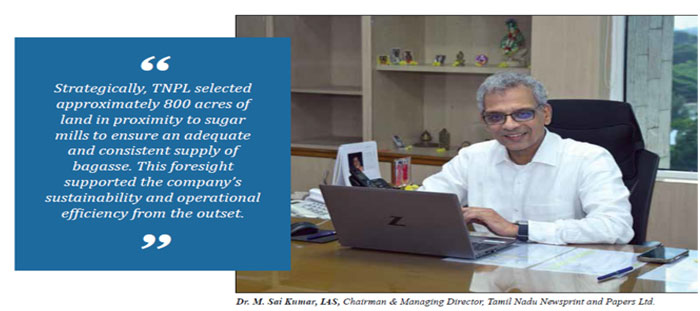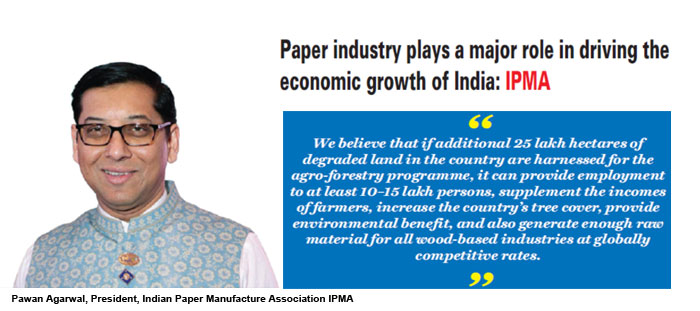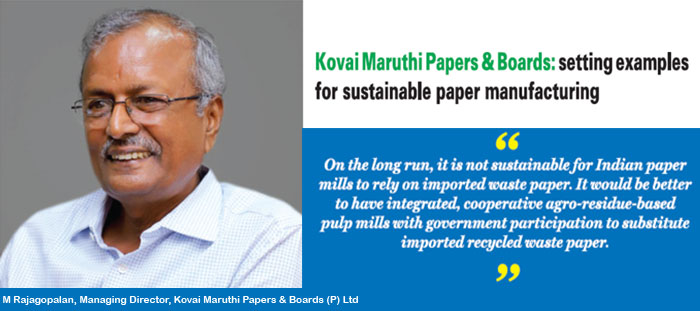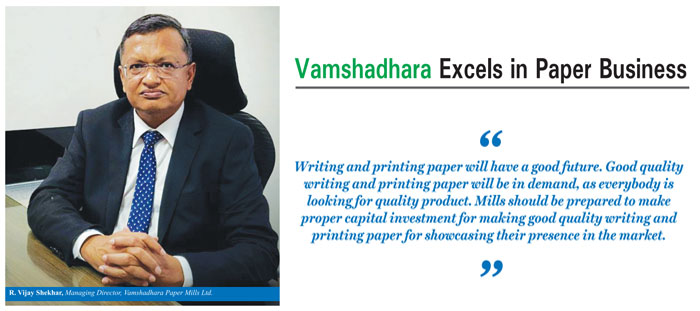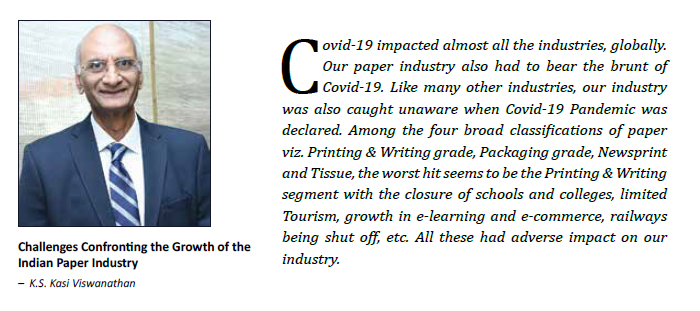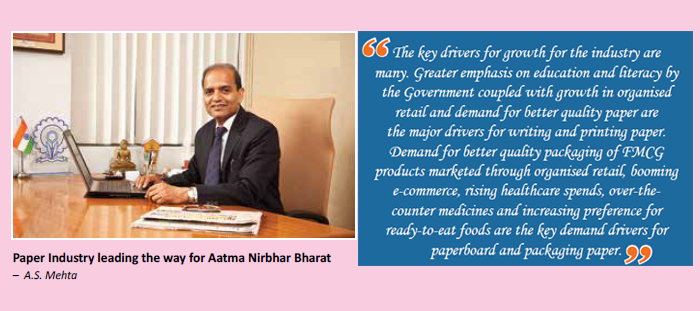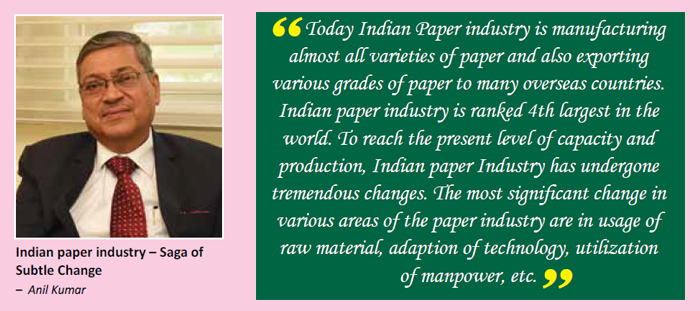| a (ClE Starlab) | Refers to the system used to describe and measure color. a indicates redness, a positive value, and greenness, a negative value. |
| Abrasion Resistance | The ability of a paper product to withstand abrasion. The degree and rate a sample loses weight under specific rubbing action by an abrading surface measures resistance. |
| Abrasive Papers | Papers covered on one or two sides with abrasive powder. |
| Absorbency | Property of pulp, paper or board to retain materials it contacts such as liquid, gas and solid substances. |
| Absorbent Papers | Examples include duplicator, blotting, filter papers, drying royal, matrix paper and toweling. |
| Accepted Stock | Part of stock that is not rejected by cleaning and/or screening. |
| Acrylic | A water-soluble polymer used in paints to make them dry to a tough and flexible consistency. |
| Additive | A mineral, chemical or dye added to pulp and coatings to give it special qualities such as opacity. |
| Against the Grain | Folding or feeding paper at right angles to the grain direction of the paper. |
| Aging | The deterioration of paper properties over time. Sunlight and heat accelerate loss of strength and brightness. |
| Air Dry | Term applied to any pulp and paper sample that has a moisture content in equilibrium with the surrounding atmospheric conditions. Air-dry pulps are assumed to contain 10% moisture. |
| Album Paper | Wood pulp paper with an antique finish used for photo album pages. |
| Alum | A papermaking chemical used for precipitating rosin size onto pulp fibers to impart water-resistant properties to the paper. It is also called aluminum sulfate. |
| Antiquarian | The largest available handmade paper (53 x 31 inches). |
| Antique | A printing paper with a rough finish but good printing surface. It is valued in book printing for its high volume characteristics. |
| Antitarnish Paper | A term originally applied to higher-weight tissues used for wrapping silverware, but now used for all papers prepared so they will not rust or discolor razor blades, needles, silverware, etc. |
| Apparent Density | Weight (mass) per unit volume of a sheet of paper obtained by dividing the basis weight by the caliper (thickness). |
| Archival Paper | A paper that can last normally 100 years. The paper is acid free, lignin free and has good color retention. |
| Avg. Brightness | The percentage of reflectivity of a sheet of pulp or paper for blue light measured under specific standard conditions. Not necessarily related to color or whiteness. |
| Azure | The light blue color used in the nomenclature of laid and wove papers. |
Glossary of Terms - Alphabetical Index
A
B
| b (ClE Starlab) | Refers to the system used to describe and measure color. b* indicates yellowness, a positive value, and blueness, a negative value. |
| Baking | A term given to the procedure of drying coatings onto papers. |
| Bank Paper | A thin, uncoated stock used for making carbon copies. |
| Barking Drum | Large rotating cylinder in which pulpwood logs are tumbled against one another to remove the bark. |
| Barrier Coat | A coating that is applied onto the non-printing side of paper to add to the opacity of the paper. |
| Base Paper | The paper for coating or other types of finishing including laminating and consisting mainly of fibers, but may contain other additives depending on its use. For example, for coated printing papers it will contain filler and sizing, but may also be surface sized. |
| Basic Size | (U.S.) The one size in each category of paper that is used to establish the weight of the sheet. Basic sizes differ from category to category. Bond and ledger papers have a basic size of 20 x 26 in.; book, offset, and text papers have a basic size of 25 x 38 in. |
| Basis Weight | The weight in pounds of a ream of paper, typically consisting of 480, 500 or 1,000 sheets of a specified size. |
| Beater | Large, longitudinally partitioned vat used to mix and mechanically work pulp with other ingredients to make paper. |
| Beating | The mechanical treatment of the fibers in water to increase surface area, flexibility and promote bonding when dried. |
| Bible Paper | Thin printing paper for use in deluxe productions such as bibles, dictionaries and high-quality publicity productions. |
| Biochemical Oxygen Demand | The amount of dissolved oxygen parts per million utilized in the aerobic biochemical oxidation of the decomposable organic matter in mill wastewater. |
| Bisulfate Pulp | Pulp made by the bisulfate cooking process using bisulfate cooking liquor. |
| Bleaching | Pertains to the type of bleaching the pulp has been exposed to. The three types are ECF, Non-ECF and TCF. |
| Blister Pack | This term describes a packaging system that is a combination of board and plastics. The board, usually made from lower grades of waste paper, can be lined in whole or in part on one or both sides, to carry a printed message or advertising. The product is sealed to the board by a transparent plastic film. This system is often used for small products with difficult shapes and sizes. |
| Blistering | Small eruptions in a paper's coating, usually from paper being dried too quickly on high-speed web offset presses. |
| Blotting Paper | Very absorbent and bulky, woodfree paper, sometimes made from a pulp of cotton or wool fibers. |
| Board | Papers of 220 g/m2 and over are generally called boards. They are often of more than one ply. |
| Bogus | Product made from wastepaper or other inferior materials in an imitation of higher-quality grades. |
| Book Paper | A term for papers used in the commercial, book and publication segment of the printing industry. |
| Bond | Class of printing/writing papers made form bleached chemical woodpulps and cotton fibers. |
| Bond Strength | An intralayer binding force in a paperboard or laminate. This term also refers to the degree of adherence of coating and film on a sheet and to the binding force in a sheet. |
| Bone Dry (b.d.) | This term refers to the moisture-free conditions of pulp paper. It also refers to air containing no vapor. |
| Box Cover Paper | A lightweight paper used expressly for covering paper boxes. |
| Box Enamel Paper | A glossy coated paper used to cover paper boxes. |
| Box Liners | A coated paper used on the inside of boxes, which are used for food. |
| Breaking Length | A mathematical calculation based on paper's tensile strength and grammage. This represents the theoretical length of a uniform width of paper that, when suspended by one end, would break by its own weight. |
| Brightness | The percentage of reflectance or brilliance of paper when measured under a specially calibrated blue light. Defined as the amount of blue-white reflectance compared to magnesium oxide, which is considered 100% bright. |
| Bristols | A heavyweight paper possessing higher-than-average quality characteristics. |
| Brocade | A heavily embossed paper. |
| Broke | Paper trimmings or paper damaged from breaks on the paper machine and in finishing operations. |
| Bulk | A measurement of the density of a sheet of paper. |
| Burst Factor | The resistance of paper to rupture when pressure is applied to a side by a specified instrument. |
| Bursting Strength | The resistance of paper to rupture when pressure is applied to a side by a specified instrument. This is also referred to as burst and pop strength. |
C
| Calendar | The assembly of rolls at the dry end of the paper machine that imparts a finish to the paper and reduces the bulk and roughness. |
| Calendar Finished | Paper and paperboard that has been passed through a calendar to improve surface characteristics by application of pressure, friction and moisture. |
| Caliper | The thickness of a sheet of paper or paperboard measured under standard test conditions. |
| Carbonizing Paper | Lightweight, unquoted paper made from unbleached chemical and/or mechanical pulps and surfaces coated with a carbon solvent or wax so that it takes up carbon inks and releases them under pressure, duplicating the inked areas being printed. |
| Carbonless Paper | Copying paper that is coated so that it can be used without carbon coating or interleaved carbon paper. |
| Carload | A quantity of paper shipped from the mill in one freight car. |
| Cast-Coated Paper | High-gloss coated paper and paperboard with surface characteristics produced by allowing applied coating to harden while in contact with surface of steam-heated, high-polished, chrome-plated drum. |
| Cellulose | The chief constituent of the cell walls of all plants used to manufacture pulp. |
| Chemical Pulp | Pulp made by cooking the wood in the presence of chemical agents (acids or alkali) which eliminates most of the non-fibrous material. |
| Chemical Oxygen Demand | The amount of oxygen required to oxidize organic and oxidizable inorganic compounds of water. |
| Chipboard | Paperboard made primarily from waste paper used mainly in packaging, especially with a white liner and coating. |
| Chlorinated Organics | A group of compounds, such as DDT, that tend to remain in the environment for a long time and tend to accumulate inside the tissues of living organisms interfering with biological processes. |
| Chlorine | A greenish-yellow, poisonous gaseous chemical used in bleaching pulp and water purification in a pulp and paper mill. |
| Clarifiers | Storage tanks in which suspended solids settle and can be removed from green and white liquors. These are located in the causticizing areas of a pulp mill. |
| Closed-cycle mill | A pulp mill concept in which all liquid effluents are recovered, which eliminates water pollution by the mill. |
| Coated | Paper and paperboards that have been coated with a material such as clay or pigment and an adhesive. |
| Color | The color of the coating mixture used to make the paper, which is either white or a specific color. |
| Combination Board | Multi-layered, cylinder-made paperboard with layers from different pulpstocks. |
| Containerboard | Another name for corrugated board used to make boxes and other containers for shipping materials. |
| Converter | A company that specializes in converting reels and sheets of paper and board into packaging or finished goods for sale to the public. |
| Cook | Treating fibrous raw materials with chemicals under heat and pressure to produce pulp for papermaking. |
| Cord | Pulpwood volume measurement indicating a pile measuring 4 ft. x 4 ft. x 8 ft., equaling 128 ft. |
| Copier/Laser Paper | Lightweight grades of good quality and dimensionally stable papers used in photocopying. |
| Coreboard | It is produced from 100% recycled fiber and needs to possess high stiffness and rigidity for core winding. Closely controlled absorbency and porosity are necessary to ensure good performance in conversion. |
| Cover Paper | A large category of papers used as a protective covering for books, pamphlets, magazines, catalogs and boxes. |
| Crepe Paper | Low-basis weight paper made from sulfite, sulfate or mechanical pulp and given a crinkly finish by crowding the web sheet over a roll with a doctor blade. |
| Cross Direction (CD) | The direction across the paper grain. |
| Cunit | Pulpwood measurement equivalent to a volume containing 100 ft. solid of unpeeled wood. |
| Curl | Tendency of paper by itself to bend or partly wrap around the axis of one of its directions. Usually caused by nonuniform distribution of strains and stresses throughout the sheet as a result of uneven internal moisture and conditioning. |
| Cut Size | Fine paper cut to specific end-use dimensions on a paper trimmer, usually of the guillotine or rotary type. |
| Cylinder Machine | Machine used to make paperboard. |
D
| De-inking | Process consisting of removing the ink and other undesirable materials from wastepaper by mechanical disintegration, chemical treatment, washing and bleaching before reusing as a source of papermaking fiber. |
| Delignification | The removal of lignin from wood. |
| Die Cut | The method of cutting paper into irregular shapes by metallic die to specified dimensions. |
| Digester | Pressure vessel for chemical treatment of chips and other fibrous materials like straw bagasse rags, etc., under elevated temperature and pressure to separate fibers and produce help. |
| Dimensional Stability | The ability of a sheet to keep original machine and cross-machine dimensions in time and under variable moisture and relative humidity conditions. |
| Diploma | A fine paper made specifically for the printing of diplomas, certificates and documents. |
| Dioxin | A carcinogenic contaminant generated when chlorine is used in bleaching woodpulp. |
| Dioxin Content | The percentage of dioxin, which is an undesirable chlorinated contaminant generated when chlorine is used in bleaching woodpulp. It is considered to be highly carcinogenic, especially in its most potent form. |
| Dry End | The part of a paper machine where sheet moisture is removed by evaporation. Consists of several dryer sections or air dryers, depending on the machine's type and size. |
| Dryers | In a paper-mill, the portion of the paper machine where the wet web is dried on large, heated rollers. Can be infrared or hot-air assisted. |
| Duplex | 1. Texture that may be produced by a multi-ply machine, using two different stocks or by lining a board with two kinds of stock: it may also be obtained by pasting (laminating) together two papers or boards of different texture. 2. General term that refers to multi-ply paper and paperboard and bags made of two sheets of paper. |
E
| Elemental Chlorine Free (ECF) | Pulp that is bleached without chlorine gas. |
| Edge Crush Test | Used to evaluate the compressive strength of containerboard used in the manufacture of corrugated shipping boxes. |
| Electronic Data Interchange (EDI) | Business information that is communicated electronically, eliminating the need for paper business forms. |
| Electrostatic Copy Paper | Smooth-finished, stable, medium-weight bond paper made from chemical pulps. This paper is generally treated with a zinc-oxide coating material and used on dry-type office copying machines. |
| Elmendorf Test | Also known as tear test. This test is commonly used in paper mills to determine the tear-resistant property of paper. |
| Elongation | The property of a paper sheet that allows it to experience a certain degree of stretching. |
| Embossed | The overall design or pattern impressed in paper when passed between metal rolls engraved with the desired pattern. Produced on a special embossing machine after the paper has dried to create finishes such as linen. |
| Enamel | A general term for clay coating on papers. |
| English Finish | A grade of book paper with a smoother, more uniform surface than machine finish. |
| Engraving | A printing process whereby images such as copy or art are etched onto a plate. |
F
| F G | A term in the binding process referring to folding and gathering. |
| Felt | 1. Woven cloth used to carry and support the web of paper between press and dryer rolls on the paper machine. Synthetic felts are mainly used. Dryer felts of cotton or synthetic materials support the paper web through the dryer section. 2. A mark or imperfection in paper caused by a coarse or grainy character of the felt. |
| Felt Side | The side of the paper that does not touch the wire on the paper machine. The top side of felt is preferred for printing because it retains more fillers. |
| Fiber | Elongated, thick-walled cellular unit that is the structural component of woody plants. |
| Filler | A material such as china clay or calcium carbonate that is added to pulpstock to fill spaces between fibers and enhance printing properties of paper made from it. |
| Fine Papers | High-quality printing/writing and cover papers with excellent surface characteristics for writing. |
| Finish | Surface characteristics of paper, such as its smoothness, gloss and appearance. |
| Finishing | Paper processes that occur after the completion of papermaking operations, including supercalendering, slitting, rewinding, trimming, sorting, etc., prior to shipment from the mill. |
| Flexographic Printing | Printing from a relief image with a rubber or plastic plate, using liquid ink of solvent or water, plus pigment dyes. Used mainly for packaging products. |
| Fluff Pulp | Thick sheet or batt of woodpulp fibers manufactured in roll or bale form and suitable for dry disintegration into individual fibers. |
| Fluorescent Paper | Paper with a high reflective quality, resulting from colored, light-emitting dyestuff materials that reflect white light. |
| Folding (Machine Direction) | Test made on paper by a folding endurance tester to measure the number of double folds that can be given to a strip of paper clamped between two jaws before it will break. This test gives an indication of the paper's ability to take abuse. |
| Formation | Physical distribution and orientation of fibers and other solid constituents in the structure of a sheet of paper that affects its appearance and other physical properties. |
| Fourdrinier Wire | Continuously traveling, endless, woven, metallic or plastic screen belt located in wet-end section of fourdrinier paper machine invented by Nicholas-Louis Robert. Pulpstock is fed onto wire so that water is drained from it as fibers become oriented to form a continuous web. |
| Freeness | The ability of pulp and water mixture to release or retain water on drainage. |
| Furnish | Various pulps, dyes, additives and other chemicals blended together in stock preparation area of paper mill and fed to wet end of paper machine to make paper or paperboard. Also called stock. |
G
| Glassine | A wood-free paper. Transparent, glazed and polished on both sides. Used as envelope windows and in protective packaging for foods, candy, tobacco products, chemicals and metallic items. |
| Gloss | A property of paper surface to produce a shiny, highly reflective appearance when light is reflected. Occurs when specular reflection exceeds the diffuse reflection from various viewing angles. Gloss is basically the measure of the reflectance of light from the surface of the Web. |
| Grain | Directional alignment of fibers in a sheet of paper. |
| Grammage | This term denotes the weight of paper or board; the measurement used is the weight of a single sheet of one square meter, expressed as gram per square meter (g/ml). |
| Grams per square meter | The gram weight of one square meter of a particular type of paper. A good comparative measure because it does not vary with sheet size. |
| Gravure Printing | An intaglio or recessed printing process. The recessed areas are like wells that form the image as paper passes through. |
| Groundwood Paper | Paper that is made from a furnish containing a large percentage of groundwood pulp. |
| Groundwood Pulp | Slurry produced by mechanically abrading fibers from barked logs through forced contact with the surface of a revolving grindstone. This is used to make newsprint and other publication papers. |
| Gummed Paper | All papers that include an adhesive on one side of the sheet. Could be a remoistening, thermo-adhesive or pressure sensitive. |
| Gypsum | A filler for paper with good retention for color and brightness. Unlike other fillers, it does not reduce the efficiency of internal sizing. |
H
| Hard-Sized | Paper: Paper treated with considerable size to resist water and ink penetration. |
| Hardwood Pulp | Pulpwood obtained from broad-leaved dicotyledonous, deciduous trees that contains good printing quality and imparts high bulk, compressibility and good opacity to the paper. |
| Hemicellulose | Alkali-soluble, non-cellulosic polysaccharide portion of a wood cell wall. |
| High-Performance Containerboard (HPC) | A linerboard and corrugating medium that meets new edge crush test specifications. HPC grades typically have high compression strength values with reduced basis weights compared with grades made to meet burst strength and basis weight specifications under old tests. |
| Holdout | The ability of paper or board to resist surface liquid penetration. |
| Hotmelts | Materials applied to paper or paperboard to produce fluid-resistant surface with high gloss. |
| Humidity | Moisture vapor in the air, which affects paper printability |
I
| Industrial paper | Paper made for industrial packaging, tissues, wrappings and insulating. |
| Integrated mill | A mill manufacturing complex that produces paper from pulp manufactured at one site. |
| Integrity | The quality of the paper surface finish. |
| International Paper Sizes | The standard range of metric paper sizes (A, B and C) as defined by the International Standards Organization |
J
| Jacket | The paper cover sometimes called the dust cover of a hardbound book. |
| Job Lot | Defective or discontinued papers made in small quantities for special orders and sometimes sold at low prices. |
| Jog | To shake a stack of papers, either on a machine or by hand, so that the edges line up. Printers jog the paper to get rid of any dust or particles, and to ensure proper feeding into the press. |
| Jumbo Roll | A roll of paper greater than 12 inches in diameter and used for converting into user products. |
K
| Kiss Impression | A delicate printed impression that is just heavy enough to be seen. |
| Kraft Pulp | A fibrous material used in pulp, paper and paperboard manufacturing that is produced by chemically reducing woodchips into their component parts by cooking in a vessel under pressure using an alkaline cooking liquor. |
| Kraft Paper | High-strength paper made from a type of chemical wood pulp; it may be bleached or unbleached and produces a strong paper which is used for wrapping and packaging |
L
| Lacquer | A clear-gloss coating applied to printed material for gloss, grease resistance, heat sealing and improved appearance. |
| Laminate | Multi-ply paper and paperboard consisting of firmly united layers that may be bonded with resin or adhesive. |
| Ledger Paper | Strong, fully-sized paper made from bleached chemical woodpulp used to make accounting and record books. |
| Letterpress Printing | Printing process in which ink is applied to paper, paperboard or film from raised portions of printing plates or type. |
| Lignin | Brown organic substance found in wood and other cellulose plants that acts as an interfiber bond in woody materials. |
| Linen Finish | A paper surface design made by embossing the paper with a linen cloth pattern. |
| Linerboard | Kraft paperboard, generally unbleached, used as facing materials in the manufacture of paperboard containers and as the outer layers of plaster building boards. |
| Long Fiber Pulp (LF) | General term given to pulps produced from soft woods such as pine. The fiber length of the pulp is long compared to that of hardwood |
M
| Machine Coated | Applying coating to paper on the paper machine on which the paper is made. This is an integral part of the papermaking operation. |
| Machine Direction | The direction from the wet end to the dry end of a paper machine or to a paper sheet parallel to its forward movement on a paper machine. Also referred to as grain direction or long direction. |
| Machine Finished | Paper that is calendered on the papermaking machines but is not supercalendered to give a very smooth finish or gloss. |
| Machine Glazed (MG) | Paper with a high-gloss surface finish produced on the wire side of a sheet by passing it over a roll as used on yankee-type paper machine dryers. |
| Manifold Paper | Very thin, regular bond paper with glazed or unglazed finish used to make carbon copies of letters. |
| Manilas | Papers and board used for making tags, high-strength cartons, correspondence folders and many other articles where strength is at a premium. |
| Matte | A physical characteristic of paper with low gloss or luster. |
| Mechanical Pulp | Groundwood pulp produced by mechanically grinding logs or wood chips. It is used mainly for newsprint and as an ingredient of base stock for lower-grade printing papers. |
| Moisture | The percentage of moisture in pulp, paper, etc. that varies according to atmospheric conditions. Moisture content of paper is normally measured by drying the paper to constant weight at 100 degrees C. Paper will normally have about 5% moisture when dry, but that value can range from 3% to 7%, depending on the type of paper and the materials used in its manufacture. |
| Moisture Content | The amount of moisture in paper, pulp, pulpboard, chips, etc., that varies according to atmospheric conditions. |
| Moistureproof | Ability of paper and paperboard to resist the penetration of water vapor. |
| Moisture Vapor Transmission | A sheet of paper's rate of water vapor penetration. |
| Mullen | Resistance of paper to rupture when pressure is applied to a side by a specified instrument. |
| Mullen Tester | A machine for testing the bursting strength of paper. |
| Multi-ply | A paper or paperboard sheet made up of two or more layers. |
N
| Newsprint | A relatively low-grade paper - combining high percentages of groundwood pulp - on which newspapers are printed. |
| Non-Coated Paper | Paper treated in a size-press (gluing-press) or pigmented paper of which the applied coating per face weighs less than 10g. |
| Ninepoint | Paperboards used as the fluted component in the manufacturing of multi-ply combined board or wrapping. |
| Nonwoven Fabric | Cloth-like material made from long natural and synthetic fibers formed from a slurry on a wire screen or by laying on a fine mesh screen from an air suspension |
O
| Off-Machine Coating | Indicates the process of applying coating material that is not performed on the paper machine, but as a separate operation. |
| Offset | The most commonly used indirect printing method in which an impression of type or a design on a flat plate is printed on a cylinder from which it is impressed upon the surface to be printed. |
| Onionskin | A thin, lightweight paper used primarily for typewritten correspondence. |
| Opacity | A property of paper that minimizes the show-through of printing from the backside or the next sheet. A paper with low opacity is more transparent. |
| Oven-Dry (OD) | Moisture-free (also bone dry) conditions of pulp and paper. Usually determined by drying a known sample to a constant weight in a completely dry atmosphere at a specified temperature |
P
| Packaging | The paper and board used for wrapping or packing goods. |
| Paper | Homogenous sheet of felted cellulose fibers, bound together by interweaving and by the use of bonding agents and made in a variety of types. |
| Paperstock | Water slurry of various pulp fibers, dyes, additives and chemicals pumped to the paper machine for formation into sheets. |
| Papeterie | A high-grade, soft paper used for personal stationery. |
| Patent Coated | Paperboard made and lined with white or colored fibers on a multi-cylinder machine, possessing a high-surface finish suitable for use in making cartons. |
| Perfect | A term used to describe the binding process where the signatures of a book are held together by a flexible adhesive. |
| Perfecting Press | A printing press that prints on both sides of the page in a single pass. |
| Picking | Pulling out paper fibers from the paper surface during printing. It occurs when the pulling force (tack) of the ink is greater than the strength of the paper. |
| Pigment | Insoluble mineral or organic powder used to coat or fill paper. Many pigments are mineral and inorganic compounds used in coating to give smooth surface and opacity. |
| Ply | The number of pieces of paper that make up a multi-layered, pasted or multi-cylinder-formed paperboard. |
| Porosity | A measurement of the ability of paper to allow fluids to pass through paper and paperboard, which is an important factor in ink penetration. |
| Preprint | Linerboard that was printed and rewound prior to the manufacture of combined board. It's used to make corrugated boxes with high graphic quality. |
| Printability | Ease with which paper can be printed to high-quality standards with the least amount of spoilage. |
| Prohibitive Materials | As published by the Institute of Scrap Recycling Industries, Inc., any materials which by their presence in a packing of paper stock, in excess of the amount allowed, will make the packaging unusable as the grade specified. Additionally, this includes any materials that may be damaging to equipment. |
| Pulp | Fibrous material produced by mechanically or chemically reducing woody plants to their component parts from which pulp, paper and paperboard sheets are formed after proper treatment. |
| Pulper | A device composed of a cylindrical vat in which a rotor separates the fibers and suspends them in water. |
Q
| Quired | A ream of paper in which the sheets are folded in half instead of flat |
R
| Rag Content | The amount of rag fibers in a sheet, varying from 25% to 100%, including bond, ledger and specialty papers. |
| Ream | Stack or package of paper containing a number of sheets - usually 480, 500 or 1,000. |
| Recovery System | System in a pulp mill where black liquor is burned and inorganic chemicals are recovered and circulated in the process. |
| Recycled | The percentage of paper of which the fibrous composition contains recovered or recycled cellulose fibers (RCF). |
| Refiner Mechanical Pulp | Pulp made by processing untreated woodchips in mechanical atmospheric refiners. |
| Refining | The process of increasing the surface area of cellulose fibers to multiply the number of contact points between them to facilitate their intertwining. Imparts such characteristics as increased capacity to absorb water and improved sheet formation. |
| Register Paper | Type of paper made specifically for easy removal from sticky surfaces. |
| Relative Humidity | The amount of water vapor present in the air as compared to the maximum potential amount. |
| Release Paper | Writing-grade paper made from chemical pulp that possesses good tensile and tearing strength. It comes in rolls for automatic register machines and in flat, folded, snap-apart packages for computer printouts and other copying purposes. |
| Resin | The vegetable excretion or exudation that results in an amorphous, lustrous-appearing, solid organic substance that is soluble in organic solvents. |
| Retention | The amount of a loading or additive added to the stock that is retained in the final sheet of paper. |
| Rosin | Material made up of a suspension and used for internal sizing of paper and paperboard. |
| Rubbed (paper or cardboard) | Paper or cardboard of which a face has been given a homogenous and shiny aspect by drying it on contact with a heated polished metal roller (part of the drying process of the paper machine). The other face of the paper or cardboard remains relatively rough. |
| Rubine | A pigment somewhat redder than true magenta. |
| Runnability | Paper properties that affect the ability of the paper to run on the printing press. |
| Running Head | A title at the top of a page that appears on all pages of a book or chapter of a book. |
S
| Safety Paper | Used mainly as bank checks and other legal documents. Safety paper is specially treated to prevent erasure, alteration or duplication of any writing or printing on its surface. |
| Satin Finish | A smooth, delicately embossed finished paper with sheen. Also called silk. |
| Scoring | To impress paper with a rule for the purpose of making folding easier. |
| Screenings | Rejected materials, such as knots, shives and large bark particles, from the screening operations of pulp suspensions in a pulp mill. |
| Secondary Fiber | Any type of paper and paperboard fiber obtained from wastepaper and other used reclaimable fiber sources. |
| Secondary Pulp | Lower-quality pulp made from waste paper and not directly from wood. |
| Semichemical Pulp | Pulp made by cooking fibrous materials in a neutral sodium sulfite/sodium carbonate cooking liquor. |
| Sheet | Flat piece of any type of pulp, paper and paperboard that has a variety of characteristics, sizes and finishes. |
| Silvichemicals | Chemical byproducts of the wood-pulping process and other chemicals derived from wood. |
| Size | Non-fibrous materials used in papermaking to control the absorbency of paper. Rosin, gelatins, glues, starch and alum are the most commonly used. |
| Sizing | This process can be applied on the surface of the sheet or in the sheet: in the first case starch is applied to the surface to increase its strength and to resist the penetration of oil-based inks (this process is carried out at the size press, which is about two-thirds of the way down the dry end); in the second case chemicals are added to the stock at the pulping stage before the sheet is formed: this is called internal or engine sizing and its purpose is to stop penetration of water-based inks into the sheet. |
| Size Press | Section of paper machine where surface treatments are applied to the sheet of paper to give it special qualities. Normally a pair of rolls toward the end of the dryer train between which the dry or partially dry web is passed, and into the nip of which a liquid, usually starch, is applied to impart strength to the sheet. |
| Slurry | A liquid mixture consisting of suspended fibers, fillers, coating pigments and other solid material in water or adhesive, used in papermaking process. |
| Slush | Pulp stock-water suspension thin enough to flow or pump through a pipeline, usually running about 1% to 6% consistency. |
| Smoothness | Texture of the surface of paper. Also called its finish. Generally determined with a tester that measures time required for a given volume of air to flow between the surfaces of the paper sample and a piece of optically flat glass under standard loading conditions. |
| Softwood | Wood obtained from evergreen, cone-bearing species of trees, such as pines, spruces and hemlocks. This imparts the strength properties to the paper. |
| Solid Board | Single-ply paperboard made from the same stock throughout the entire sheet structure. |
| Spent Liquor | Used cooking liquor on a chemical pulp mill that is separated from the pulp after the cooking process. It contains lignins, resins and other substances extracted from the material being cooked. |
| Specialty Papers and Boards | This is a term applied to such grades as off-machine coated, laminated, impregnated etc. as distinguished from printings and writings and other grades that do not require further processing. Specialty papers and boards are often the raw materials used by other industries. |
| Spiral Bind | A binding that includes wire or plastic that is spiraled through holes punched along the binding side. |
| Splice | A joint made in a continuous sheet of paper with glue or adhesive tape when a break occurs in the web during winding or rewinding into a roll. |
| Spool | Continuous roll of paper or cardboard rolled around a mandrel. |
| Standard Conditions | This is assumed to be 29.92 in. of mercury and 70 degrees Fahrenheit. |
| Starch | Material made primarily from corn and potatoes that is used as a surface or internal additive to provide strength. |
| Stiffness | A quality of paper alluding to its rigidity and resistance to bending and inflexibility. |
| Stock | This refers to the wet pulp before it is fed onto a papermaking machine, or during the papermaking processes before it becomes a sheet of paper; contains around 99% water and 1% fiber. In graphic arts, stock means paper. |
| Stretch | The give of a sheet of paper as it undergoes tensile pressure. |
| Sulfate Process | An alkaline pulp manufacturing process made by using wood chips cooked under pressure in a solution of caustic soda and sodium sulfite. Also known as kraft process. |
| Sulfite | An acid pulp manufacturing process in which chips are reduced to their component parts by cooking in a pressurized vessel using a liquor composed of calcium, sodium magnesium or ammonia salts of sulfurous acid. |
| Sulfite Pulp | Paper pulp made from wood chips cooked under pressure in a solution of bi-sulfite of lime. |
| Supercalender | Auxiliary piece of equipment that gives paper a very smooth surface by passing it through a series of alternate metal and composition rolls, revolving with high speed and pressure. |
| Surfaced (paper) | Paper having undergone a coating process to one or both sides to improve the characteristics of its surface. |
| Synthetic Fibers | Any petroleum-based waterproof papers with a high tensile strength. |
T
| Tack | Sticky property of paper and paperboard adhesive and glue-coating materials. |
| Tag | A strong, dense paper stock. |
| Tall Oil | By-product made from the resins, fatty acids and soap removed during the evaporation of sulfate black liquor. |
| TCF | Total chlorine-free pulp bleached without compounds such as chlorine dioxide. |
| Tear Cross Directional | The resistant property of a sheet of paper to tearing, usually measured by the force required to tear a strip under standard conditions. |
| Tear Index | The force required to tear a sheet of paper under standard conditions. |
| Tear Strength | The resistant property of a sheet of paper to tearing, usually measured by the force required to tear a strip under standard conditions. |
| Tearing-Strength Test | Strength test of paper designed to show how much force the paper will stand before it tears. |
| Tensile Cross Directional | The resistant property of a sheet of paper to stress produced by tension, usually measured by the force required to break a strip of paper under standard conditions. |
| Tensile Strength | The resistant property of a sheet of paper to stress produced by tension, usually measured by the force required to break a strip of paper under standard conditions. |
| Test Linerboard | Used as the outer layer of a corrugated construction, the material being made partly from chemical pulp and partly from waste paper. |
| Text Paper | A high-quality printing paper with a medium, vellum-like finish. |
| Thermomechanical Pulp (TMP) | Pulp made by presteaming wood chips, producing a higher yield and stronger pulp than regular groundwood. |
| Tissue Paper | Soft, lightweight paper used for hygienic and household purposes. |
| Total Outthrows | As published by the Institute of Scrap Recycling Industries Inc., the term outthrows is defined as all papers that are so manufactured or treated or are in such a form as to be unsuitable for consumption as the grade specified. |
| Translucency | The ability to transmit light without being transparent. |
| Transparency | Ability of paper to allow light rays to pass through so that objects behind it can be clearly seen. |
| Treated (paper) | Paper treated mechanically in the paper machine to improve the smoothness and uniformity of the two sides: the paper is rubbed, smoothed and calendered. |
| Trim | The dimension of the widest sheet of paper that can be made on a paper machine, excluding the edges that are normally cut off. |
| Twin-wire Former | A multi-ply paperboard machine with two wires, or fabrics, between which the sheet is formed. |
| Two-Sidedness | The difference in appearance and printability between a piece of paper's top (felt) and wire sides. |
U
| Uncalendered | Papers that are not smoothed by going through the calendering process. |
| Up | A term used to describe how many similar sheets can be produced on a larger sheet; two up, four up, etc. |
| UV Coating | A slick, glossy coating applied to the printed paper surface and dried on press with ultraviolet (UV) light. The slick surface of UV coating makes it popular for printing the covers of paperback novels. |
| UV Ink | Ink specially formulated to dry quickly with ultraviolet (UV) light while still on press. UV drying improves turnaround time because it eliminates waiting time for the first side to dry before printing the second side |
V
| Varnishing | Applying varnish or lacquer on a material or a composite. As with the application of a film, varnishing aims to protect the printing and to increase the paper's glossiness, as well as improve its barrier properties. |
| Vellum Finish | Smooth, dull finish applied to book and stationery paper surfaces to simulate sheets originally made from calf skin. Vellum is also used to designate heavy weight, translucent drawing of drafting papers. |
| Velour Paper | A term given to papers that are coated with an adhesive and then flock dusted. |
| Viscosity | The measure of the extent to which a fluid resists the force, tending to cause the fluid to flow. |
W
| Wadding | Single or multi-ply, loosely matted fiber sheet made from chemical pulp. Used in packaging, thermal and acoustical applications and as a cushioning medium. |
| Wastepaper | All types of used paper that provide a source of fiber for the manufacture of some papers, paperboards and chipboards. |
| Web | Continuous sheet of paper produced and rolled up at full width used in web or rotary printing. |
| Web Break | A tear in a web roll during the printing process. |
| Web Press | A printing press that prints on rolls of paper passed through the press in one continuous piece, as opposed to sheets of paper. |
| Web Tension | The term given to the tension or pull exerted by the web press on the web roll. |
| Wet End | Section of the head end of a paper machine. At the wet end, stock is fed in and much of water is eliminated by drainage, suction and press rollers, leaving a web of paper which then passes through the drying cylinders. |
| Wet Machine | Paper machine consisting of a wire-covered cylinder rotating in a vat of pulpstock on which a mat of varying thickness is formed by drainage. These mats are removed either intermittently in thick sheets called laps or continuously. |
| Wet-strength Paper | Paper where the fiber constitutes and/or the sheets are chemically treated to enhance their resistance to tearing, rupturing or disintegration after becoming saturated with liquids. |
| Wet Strength | Resistance of a paper sheet to pull or stress produced by applied tension after it has become saturated with liquids. |
| Wet Tensile Strength | Resistance of a paper sheet to pull or stress produced by applied tension after is has become saturated with liquids. |
| Whiteness | Paper is perceived to be white due to high clarity, elevated diffusion and minimum perception of hues. It is related to the color of the sheet and actually is the equal presence of all colors. |
| White Paper | Any paper made from a pulpstock whose natural color has been corrected by the addition of blue, yellow and red dyestuff. To a printer, this term refers to any paper that is devoid of any printing material. |
| Wire Side | The side of a sheet next to the wire in manufacturing; opposite from the felt or top side; usually not as smooth as the felt or top side. |
| Wire Marks | Small impressions produced on the bottom surface of a sheet of paper caused by the mesh of the wire screen on which the wet web is formed in the wet end of a paper machine. |
| Wood Free | Paper made only from chemical pulp and free from wood-based impurities, such as lignin, which are present in mechanical pulp. Also known as freesheet. |
| Writing Paper | Another name for bond paper. |
W
| Xerographic Paper | Papers that reproduce well in copy machines and laser printers. |
| Xylem | Part of a tree between the bark and the pith that forms the mechanical structure constituting the wood from which the fiber is obtained for use in pulp and papermaking. |
Y
| Yankee Dryer | A steam-heated paper dryer consisting of a large revolving drum equipped with a felt to hold the sheet in contact with its highly polished surface. These are commonly used for drying tissue-type papers. |
| Yield | The ratio for the amount of raw material entering a pulp and papermaking operation to the equivalent product output. |
Z
| Z-Directional Strength | The strength of paper and board as related to the force. This is measured by tension applied to the surfaces of the test sample. |

